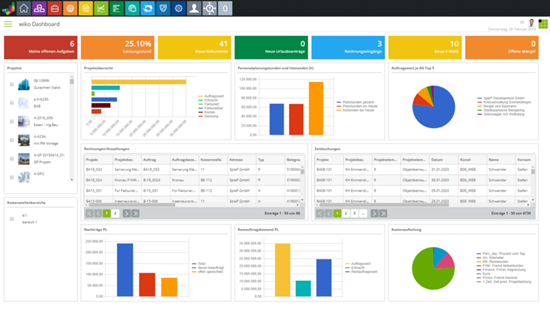In the previous topic, you learned about the importance of developing the project scope and relevant plans, processes, and documentation, as well as how you can contribute to developing and confirming them.
In this topic, you will learn about the importance of following agreed scope management plans and procedures and the steps involved in identifying and reporting non-compliances and variations.
The identification of variations and non-compliances is an essential aspect of your role as the project assistant, as deviations will inevitably lead to issues, such as an increase in resources and potentially the failure and/or delay of the project.
This topic covers the skills and knowledge required for you to:
- Undertake work according to the agreed project scope management plan
- Identify and respond to variations according to established change control procedures within the scope of own responsibility
- Communicate instances of non-compliance with the overall scope to the project manager and other team members.

Your role requires that you follow the agreed project scope management plan, including established change control procedures and performance measurement indicators (as discussed previously), as much as other stakeholders complete their work in line with those plans and procedures.
This means that you need to evaluate your own and other’s performance against agreed procedures, which can include self-reflection, observations, and interviews to establish compliance with agreed plans and procedures.
Following agreed plans and procedures also includes that you assume responsibility on the crucial tasks such as, but not limited to, the following:
- Completing allocated project tasks within designated timelines
- Regularly reviewing task status against task schedules
- Referring to agreed plans and procedures to verify your and others' compliance
- Communicating any difficulties with following agreed plans and procedures.

Your role will require that you analyse the project status against the project scope, charter, plan, and other relevant project documentation to identify any variations.
You have already established that a project does not necessarily go to plan. Issues will arise which will need to be documented and resolved.
Some issues require changing the scope, cost, timeframe, or quality parameters. Other issues will require changes to the staffing, the communications processes, the risk management, or the procurement. However, it is essential that you respond to the identified variations according to the established change control procedure and within the scope of your own responsibility to avoid further issues. Acting within your responsibility ensures accountability, reduces risks, and prevents disruptions to the project by ensuring changes are handled by the appropriate authorities.
Factors likely to impact project scope and lead to variations to the scope were already discussed previously.
Those include but are not limited to changes in:
- Resources
- Stakeholder needs
- Timeline
- Risk
- Scope
- Funding
- Management and stakeholders
- Legislative and regulatory requirements
- Environmental factors
As mentioned, the factors that impact project scope inevitably bring changes to it. However, note that a change in one element of the project will also create a change in other elements. Examples of these changes include, but not limited to, the following:
| Scope |
|
| Time |
|
| Cost |
|
| Quality |
|
| Human Resources |
|
| Communications |
|
| Risk Management |
|
| Procurement |
|
Identify Variations
The best way to identify variations is by regularly holding project meetings with all project stakeholders in order to identify the current status against targets.
Each stakeholder should report on their progress, completed tasks, outstanding tasks, and issues that need to be addressed.
You can also review project documentation, e.g. open points lists, to identify the status and any delays, excess expenditures, and quality issues.
Medium and large projects will always require status updates to be produced, e.g. weekly. Those tend to be short and to the point, showing the current progress against measurable objectives. The following image shows a project dashboard used for reporting the project status and highlighting variations to targets:

While you may not need to develop the reports, you can use them to identify the status and any variations that need to be responded to.
Other ways to establish the performance of the project and to identify variation and/or discrepancies include the measurement and comparison of current and target:
- Timelines for milestones, activities, and tasks
- Expenditures
- Return on investment (ROI)
- Individual team member performance measurement (e.g. according to performance management plan)
- Key performance indicators (KPIs)
Responding to Variations
You will be required to respond to any deviations you have identified. This may include:
- Logging the issue on the issue register
- Investigating the issue to uncover the root cause of the variations, e.g. costs may have gone up due to material shortages which increased the market price
- Raising the issue with your project manager, e.g. face-2-face or via email
- Preparing a change request for submission to your project manager.
Make sure to take the appropriate action that is within the scope of your responsibility. Refer to the stakeholder analysis and the project management plan to identify which types of responses you are allowed to take as part of your project role.
Issue register
In an ideal world, a project will run from start to finish without any problems at all. Everyone does their job, and the project is completed to scope, time, and cost, meeting all quality standards. However, such projects are rare.
There will always be problems in any project you work with. Once the planning of the project is complete, and it launches into the implementation stage, the primary role of the project manager and the project assistants is to identify problems and variations and work them through to solutions. This is where you need an issue register. By documenting all the issues and variations from the scope as they occur, including budget and cost variations, you can keep track of them and resolve them.
As the issue register gets bigger, you may start to see patterns emerging. You will then realise that for some recurring issues, there is a root cause creating a systemic problem leading to the smaller issues.
Some organisations have an issue tracking software. This allows any stakeholder to populate the issues and then for project managers to assign the issues electronically to staff members to solve.
Other organisations use a simple format table such as the supplied issue register template. An issue register could vary in complexity from a single line item in a table per issue to a full-page form per issue.
You need to determine an issue reporting system that is going to work well with your organisation. A simple tabular system should work fine most of the time, perhaps with the more significant issues documented into the big issue to page templates.
At a minimum, the issue register should have the following:
- An issues register system
- The time/date the issue was raised
- A description of the problem or variation
- Who raised the issue
- The action history, describing both the process and the solution.
- The status of the issue
Example of an Issue Register template
The following template shows an issue register used to log issues as they occur throughout the project life cycle. Issues should be logged, including their date, who identified the issue, a description of the issue, required actions, and the status of the actions.
| Issue # | Date/time raised | Description | Who raised | Action History | Status open/closed |
|---|---|---|---|---|---|
Reading
Click here for a free issue-tracking template provided by SmartSheet, which you can use to manage project issues and variations.Following Change Control Procedures and Scope Control Methods
Scope control relates to the monitoring of the project status and managing changes to the project scope. Changes must be carried out in line with change control procedures. Those procedures stipulate how a change to the project scope should be submitted, approved, and managed. Those procedures are documented in the project scope management plan, as discussed previously.
Change control procedures
Change control procedures include the following activities:
- Recording variations
- Adjusting project scope documentation in response to scope changes approved by relevant authority
- Identifying and monitoring designated elements of the project scope likely to change
- Identifying and monitoring pressures that may influence scope creep
- Maintaining scope change documentation for project audit
Change control procedures may vary depending on the industry, organisation, or individual project. Therefore, make sure to always refer to and follow your organisations and project’s change control procedures for guidance. This will be discussed in detail in the next topic.
Controlling the project scope means reviewing the project status and identifying variances to the scope. Variances may relate to budget, time, quality, or other variances to the plan. For example, costs may have increased unexpectedly and are now below the approved budget, or tasks may have taken longer to implement due to a shortage of resources.
Variances are identified by comparing the baseline plans (e.g. schedules, budgets, KPIs) with the actual performance. The output of such comparisons will highlight gaps and may lead to the need to adjust the project scope through a formal change request.
The steps you should take the control the scope include:
- Measure performance against scope
- Identify variances
- Identify if a change to scope is required
- Evaluate the impact of the change
- Request a change to scope if needed and update scope and relevant documents
Project management software streamlines change control by providing a centralised platform to submit, track, and approve changes, ensuring that all scope variations are documented and managed in real-time. It enables team collaboration, tracks approvals, and ensures that changes are implemented systematically without disrupting the project's progress.
Here’s an example change log to give you an idea of what to include and how to format your own. This change control example includes:
- Project name
- Task name
- Assignee
- Due date
- Priority status
- Progress status
- Change type
This simple format is a great starting point for a change log, but you may choose to add additional fields depending on the complexity of your project.
Scope Control Methods
If a scope change is required, then you will need to formally request a scope change by following the agreed change request procedure. Once the change has been approved, you will then need to update the project management plan.
Click on the following methods to learn more.
Check your understanding
Read the following statements and decide whether they are TRUE or FALSE to test your understanding of this topic:

As mentioned above, you are required to report any identified non-compliances and variations to your project manager and other relevant stakeholders, e.g. face-to-face or via email. You should provide the full details of the issue without delay.
By reporting such issues promptly, you can prevent the issue from spreading into a massive problem. This approach will limit the negative impacts and conserve resources. Take the time to raise and discuss any instances of non-compliance with the agreed scope, plans, and procedures, which may have led to the project scope change. Reiterate the agreed plans and procedures and the need and benefits to follow plans and procedures.
Instances of non-compliance can be communicated to the project manager and other team members in the following ways:
- In a formal meeting
- Via email
- By sending a report about the non-compliance and proposed actions to avoid further non-compliances.
The benefits of using a formal meeting to communicate non-compliance with the overall scope and relevant plans and procedures are that you will be able to provide more detailed information on what happened, where it happened, why it happened, and how it happened. You can also ask for feedback to help identify reasons for non-compliance and elicit suggestions on how those can be prevented in the future.
When communicating non-compliances, you must not blame anyone but rather seek to understand the root causes that may have led to those non-compliances. Remember that people usually seek to do the right thing, and if non-compliances occur, then there may have been reasons that led to it, which you are not aware of.
Reading
Click here to learn more about change management processes for projects.Check your understanding
Read the following case study, then try to answer the questions that follow to test your knowledge and understanding of this topic:
Case Study
As the project manager, you have just received a report concerning an incident in the team. Olivia failed to complete her assigned tasks because of non-compliance with work procedures by some of her team members.
To solve the problem, you then initiate a formal meeting to properly address the issue within the team. Olivia was able to provide critical details in the meeting and was able to explain what happened, and how non-compliance affected the workflow. The disregard to follow the appropriate procedures impacted her role caused confusion and delayed her work.
The meeting was fruitful as it allowed the team members an opportunity to explain their side. By the end of the discussion, important feedback is voiced, and suggestions were placed.
Thanks to Olivia’s quick actions by reporting such issues, potential problems such as argument and misunderstanding was prevented. The negative impact of the issue was thankfully limited.
1. What is the non-compliance issue in the team?
2. What is the purpose of reporting non-compliance issues?
3. What is the communication method used to report non-compliance?
4. What are the benefits of using formal meetings to communicate non-compliance?
